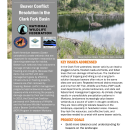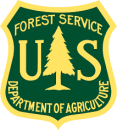Location
States
MontanaEcosystem
River/streamIntroduction
The North American beaver (Castor canadensis) has shaped its environment for millennia by chewing down trees to build dams, creating ponds for their lodges. Beaver-created wetlands provide important habitat for both aquatic and terrestrial species throughout the United States. As human-induced climate change climate change
Climate change includes both global warming driven by human-induced emissions of greenhouse gases and the resulting large-scale shifts in weather patterns. Though there have been previous periods of climatic change, since the mid-20th century humans have had an unprecedented impact on Earth's climate system and caused change on a global scale.
Learn more about climate change impacts precipitation patterns, beaver engineering is increasingly considered an important part of ecosystem restoration projects.
Beaver-modified habitats play an important role in managing droughts and flooding, which are predicted to become more severe with climate change (Jordan C. & Fairfax E., 2022). The Montana Climate Assessment found that Montana will experience earlier snowmelt in the future, reducing water availability for ranchers in an already seasonally arid landscape. Encouraging more beaver-dammed areas will increase water storage on the landscape, improve water quality by increasing water depth and reducing stream temperatures, and increase nutrient availability in the water (Brazier, R E. et al., 2020). Beaver dams also allow water to slow and spread out, reconnect streams to their floodplains, and mitigate flooding. Montana will also experience a greater risk of wildfires as a result of higher temperatures, and beaver-created wetlands are resilient to burning.
Since European settlement began, the North American beaver population has been reduced by 80-90% from its historic level (Scamardo, J. et al., 2022). Throughout the U.S., beavers were trapped for their fur and removed from the landscape to prevent the damming of water sources. Because their dam-building activity can cause problematic landscape changes for humans, such as flooding pastures, beavers are often in conflict with landowners’ goals. In the past, the main approach to beaver management has been trapping and killing.
In parts of the U.S., including Oregon and Massachusetts, state conservation agencies and nonprofits have implemented beaver conflict management programs since the 1990s to help landowners access the benefits of beavers on the landscape while minimizing property damage caused by beaver dam creation. The result has been mutually beneficial for landowners, landscapes, and the beavers.
Using the conflict management techniques pioneered in Oregon and Massachusetts, in 2019 the Clark Fork Coalition partnered with Defenders of Wildlife and the National Wildlife Federation to pilot a Beaver Conflict Resolution (BCR) Program in western Montana in the Clark Fork River Basin. The program works with landowners and state and federal agencies to reduce human-beaver conflict. By implementing low-cost tools and strategies to reduce or redirect beaver activity, landowners and the public receive the benefits of beaver dam building while reducing damage complaints. The long-term goal of the program is to increase tolerance for beaver activity so people are more tolerant of beaver restoration efforts throughout the entire landscape.
Key Issues Addressed
Landowner and land management agency concerns with beaver activity in the Clark Fork watershed include plugged culverts, flooded roads and fields, and felled trees that can damage infrastructure. A hallmark of beaver-landowner conflict is that ideal beaver habitat will attract beaver activity over and over again. The traditional method of managing this type of conflict has been the issuance of beaver damage permits by the Montana state department of Fish, Wildlife and Parks (FWP), which authorizes lethal removal of beavers outside the trapping season. However, this approach often fails to provide the long-term solutions needed to support land and wildlife management goals. Beavers often return to the same site, and repeated removal drains resources and time from everyone experiencing beaver-related conflicts, including FWP staff, road departments, private landowners, and state and federal land management agencies.
As climate change affects the hydrologic cycle in Montana, there is less water available on the landscape when ranchers and farmers need it. Beaver wetlands can provide a welcome source. As a result, landowners are increasingly willing to tolerate beavers, especially in areas such as headwaters. However, beaver activity is unpredictable; for every dam that helps fill a livestock pond, there may be a dam that floods a road or valley where ranching or development is impacted.
In the Clark Fork watershed, landowners expressed interest in finding ways to co-exist with beavers so their properties can benefit from beaver-built wetlands while addressing areas where beaver activity is undesirable. However, they lacked the resources, cost-effective tools, and expertise needed to deter beavers in a nonlethal way.
Project Goals
- Build more tolerance and understanding for beavers on the landscape
- Reduce beaver conflicts using nonlethal methods
- Train partner organizations to implement nonlethal methods
Project Highlights
Benefitting from Beavers: Many Montana landowners want the benefits of beaver wetlands. The Beaver Conflict Resolution Program provides resources to address landowner concerns such as flooding or tree felling.
- A Path to Coexistence: FWP refers landowners with beaver conflicts to the program if they are interested in pursuing coexistence. The Beaver Specialist completes an initial site assessment, and if the landowner wants to move forward with the process, provides a cost estimate and starts the permitting process (permits are required for in-stream work such as pond levelers and culvert fencing). The FWP issues SPA 124 permits and conservation districts issue 310 permits. Defenders of Wildlife provides some cost-share for the installation, while maintenance and upkeep are covered by the landowner. The Beaver Specialist monitors the installations to collect data on how the devices are functioning and the status of the beaver population in the area.
- Simple, Low-Cost Devices: To address obstructed culverts, the Beaver Specialist installs a culvert fencing device, which prevents the beaver from plugging the culvert. If beaver dams are causing problematic flooding, the Specialist uses pond levelers or pipe devices to lower water levels upstream of the dam. Tree fencing protects mature trees as well as groups of saplings.
- Resource and Time Efficiency: When beaver conflicts are addressed through nonlethal methods, FWP staff can spend less time issuing permits and responding to complaints. For example, when a culvert fencing device is installed to stop beaver dam creation in the culvert, road crews who previously had to repeatedly unblock culverts and address flooded roads can address other Department of Transportation priorities.
- By the Numbers: The Beaver Conflict Resolution Program worked with landowners to complete eight projects the first year, six projects in 2020, 17 projects in 2021,15 projects in 2022, and another 15 in 2023. About fifty percent of the BCR installations are tree fencing, with culvert fencing the second most common method.
Lessons Learned
Landowners’ experiences, and their word-of-mouth outreach to neighbors and communities, are key to the expansion of the program. Initially, some landowners were concerned that devices would not be effective because of poorly installed or maintained devices used in the past. However, the program has been in place for six years, maintenance recommendations have been established, and landowners in the Clark Fork basin increasingly accept the coexistence approach to beaver management on their properties.
Training partners takes time. The BCR Program is working with nonprofits and federal and state agencies to train staff members in conflict-resolution techniques. Though the trainings have been effective, every situation is unique and it is difficult to standardize all the considerations needed in each conflict. The Beaver Specialist visits the sites and provides tailored recommendations. Each installation needs to both manage the issue as well as accommodate the beaver’s response to variables such as pond height.
The process to design and implement these coexistence devices can take up to a month because the process required by conservation districts to issue in-stream permits can take up to a month. Processing a damage permit takes a few days. Depending on the situation, a month can be too long for a landowner to wait, or the Specialist may get the permit and find the beaver has already left the area. Some projects cannot move forward without the beavers; for example, when using a pond leveler, a beaver needs to be present to maintain the dam.
Next Steps
- Expand Beaver Conflict Resolution Program into additional FWP regions by collaborating with smaller watershed groups
- Train two additional Beaver Specialists in FWP Regions 3 and 4
Funding Partners
- Defenders of Wildlife
- Montana Freshwater Partners
- Sacajawea Audubon Society
- Montana Fish, Wildlife and Parks
Resources
- Clark Fork Coalition--Wildlife Coexistence
- NWF Montana Beaver Conflict Resolution Project
- Brazier RE, Puttock A, Graham HA, Auster RE, Davies KH, Brown CML. (2021) Beaver: Nature's ecosystem engineers. WIREs Water. 8(1):e1494. https://doi.org/10.1002/wat2.1494.
- Clark Fork Coalition. (August 21, 2020). Beaver Conflict Resolution Projects. [Youtube]. https://www.youtube.com/watch?v=Ux6Pf6hJOrg
- Jordan, C E. and Fairfax, E. (2022). Beaver: The North American freshwater climate action plan. WIREs Waters. 9(4). https://doi.org/10.1002/wat2.1592
- Ritter, T. et al. (2023). Beavers and their role in riparian riparian
Definition of riparian habitat or riparian areas.
Learn more about riparian restoration in Montana. [White paper]. Montana Fish Wildlife and Parks. https://fwp.mt.gov/binaries/content/assets/fwp/conservation/beaver/beaver-restoration-white-paper---version-1.0---fwp---2023.pdf - Scamardo, J.E., Marshall S., and Wohl, E. 2022. Estimating widespread beaver dam loss: Habitat decline and surface storage loss at a regional scale. Ecosphere 13(3): e3962. https://doi.org/10.1002/ecs2.3962
- Living with beavers | Snohomish County, WA. (n.d.). Snohomish County, WA - Official Website | Official Website. https://snohomishcountywa.gov/3989/Living-with-Beavers
Contact
Elissa Chott, Project Coordinator, National Wildlife Federation: chotte@nwf.org
CART Lead Author
Lindsey Smith, CART Case Study Writer, Miami University
Suggested Citation
Smith, L. and Chott, E. (2024). “Beaver Conflict Resolution in the Clark Fork Basin.” CART. Retrieved from https://www.fws.gov/project/beaver-conflict-resolution.








